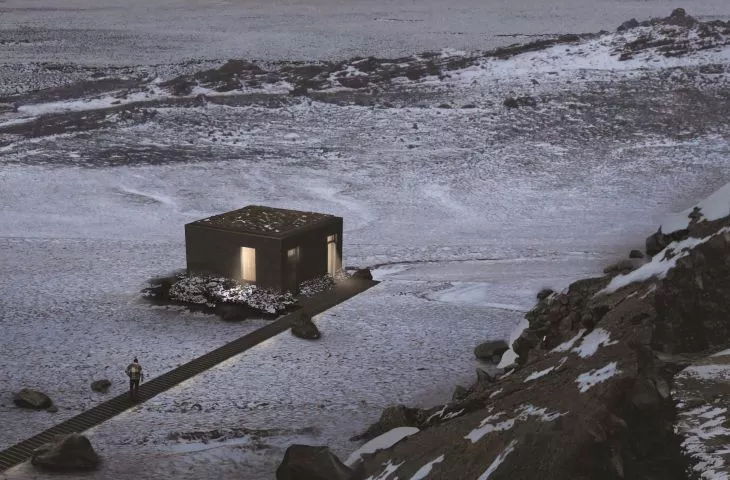Designing a tourist center and a viewpoint at the junction of two tectonic plates - that was the task of the Iceland Cave Tower Competition organized by Bee Breeders. Paulina Rogalska and Kamila Szatanowska of {tag:pracownie} approached the guidelines a bit differently, creating Hófsemi, a project full of moderation and respect for the surrounding nature, for which they received third prize.
Icelandic caves
The Grjótagjá c aves located in the north of Iceland are home to some of the most beautiful geothermal pools in the world, popularized by the "Game of Thrones" series. The caves and the distinctive meeting point of two tectonic plates - the Eurasian and the North American - attract crowds of tourists hungry for Instagram shots every year. Unfortunately, increased tourism works to the detriment of Iceland's fragile natural environment, especially the vegetation that covers the lava flows. The owners of the area and the Bee Breeders platform, wanting to protect it but also not shut out the curiosity of visitors, sought a solution to reconcile interests - to create a tourist spot that would limit the uncontrolled influx of visitors to the area.
the architects' project tells the story of the departure from the original idea
© FALA Architecture
third prize for FALA Architektura
From among the numerous projects submitted, the competition jury consisting of: Louis Becker (Henning Larsen), Marshall Blecher (Marshall Blecher Studio), Jette Hopp (Snohetta), Borghildur Indriðadóttir, Kristina Loock (GMP) decided to award the third prize to Paulina Rogalska and Kamila Szatanowska of FALA Architektura.
As the jury's justification reads:
Hófsemi is a well-resolved proposal with a unique vantage point, strongly connected to the surrounding landscape. The project proposes three distinct black forms housing a visitor center, viewing platform, restrooms and showers. The viewing platform appears to levitate above the fissure, with an open metal bridge grating that allows the visitor to observe tectonic plates as they traverse the gorge. [The jury also praised the design of the elevated walking path for its visual and physical connection to the main building.
The observation point is formed by a slender tower
© FALA Architecture
hófsemi [moderation].
Responding to the competition task, architects Paulina Rogalska and Kamila Szatanowska created a design that contradicts the competition's objectives.
This project presents a story of departure from an idea. It is a conscious defiance of the natural aspirations behind the realization of the competition assumptions. In this project you can't isolate the part of the description about sustainable solutions - it is entirely it. What was the first thought? An architectural icon - a multifunctional block on the joining of tectonic plates, a landmark, a competition dream. The turning point in the design process was to step back and admit to myself that expressing my solid fantasy would be convenient, and not necessarily right. What seemed appropriate was to give voice to nature - a unique phenomenon that this architecture is only meant to complement infrastructurally, the authors explain.
Thus, instead of a multifunctional block dominating the landscape and towering over the crack, three smaller blocks were created - simple in form and function, emerging from the Icelandic black earth. It became a priority for the architects, during the design process, to make maximum use of the already degraded pavement and to interfere as little as possible with the structure of the previously untouched lava rocks. This approach dictated the framework within which the authors placed functions.
The objects are made of black concrete
© FALA Architecture
The first solid we encounter in the parking lot is an information center with a café and office. Positioned below the hill, it is easily accessible and located in such a way as to separate the Kvennagjá cave from the main tourist traffic concentrated near the other Karlagjá cave. The footbridge is accessed via an information center, where the visitor will buy an entrance ticket, enjoy a cup of coffee and learn more about the area. Walking further, he will encounter a small sanitary facility with changing rooms and showers, where he will prepare for a thermal bath. Separating the communication and limiting it to the existing parking lot and access road, will help the degraded area regain its former natural qualities.
The third mass is formed by a slender tower connected to a footbridge, which is also its structural base. This minimalist landmark will allow one to see the vastness of the crack and the surrounding volcanoes. The passage to the other side is symbolic, and the infrastructure restricts movement across the Eurasian plate.
sustainable architecture
In the Environmental Performance Index, Iceland ranks first, with the highest score for availability of clean drinking water and sanitation. It is also a great source of geothermal energy. For flushing toilets and washing dishes, the architects suggested using a rainwater recovery tank and gray water. Precipitation in Iceland is frequent and often stormy. Flat green roofs will therefore help with water retention. The reservoirs will allow taking advantage of these exceptional weather conditions.
The designed architecture is a setting for Icelandic nature
© FALA Architecture
A sustainable building is one that respects the found environment, is easy to use, compact and made of low-emission materials. In the case of the designed buildings, the authors applied all of these elements. The structure of the building is based on recycled concrete shells and wood. The shells of the black blocks, emerging from the volcanic earth, are made of recycled concrete with an admixture of dust and crushed volcanic rock, which gives the blocks their characteristic black, slightly shiny coat. Refreshed demolition wood has found its place in the interior, adding a warm touch that contrasts with the raw exterior.
The contact of tectonic plates and the beauty of the caves are the pearls of the inflicted location. The designed architecture, in the Icelandic spirit, is only its minimalist setting, the architects add.
The same competition was attended by UAP students, who received as many as two awards for their project The Moving Surfaces : second place and a student award. Paulina Rogalska and Kamila Szatanowska are also authors of another competition project IN.VISIBLE, for which they received first prize.









































